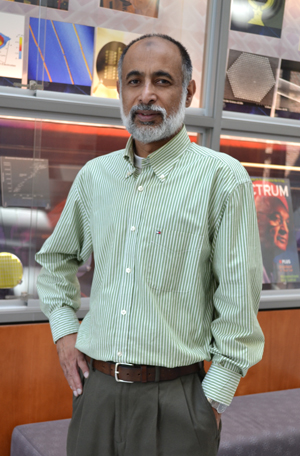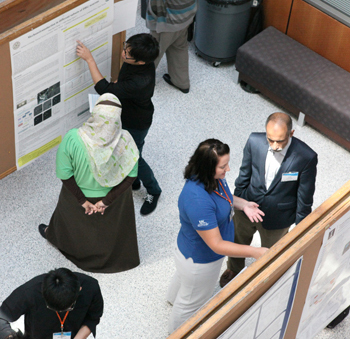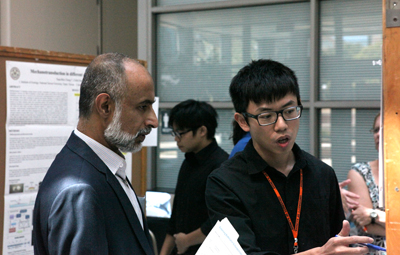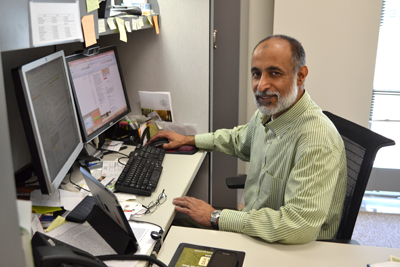The Face of Nanotechnology at Illinois, CNST Promotes Interdisciplinary Collaboration

Irfan Ahmad, Executive Director for the Center for Nanoscale Science and Technology
September 14, 2012
Illinois' Center for Nanoscale Science and Technology (CNST) works to provide training and to foster collaboration in nanotechnology at the intersection of engineering and biology.
Why should engineers need to learn about biology?
According to Irfan Ahmad, Executive Director of CNST, the national academies have identified the 21st century as the century of biology.
"So that means that we are mimicking biology; we are trying to come up with techniques, tools, processes which we learn from biology." However, Ahmad acknowledges that "Some of us who were trained as engineers did not have good grounding in the biological or life science aspects." So this is a void CNST is trying to fill.
Ahmad calls CNST a virtual center designed to "bring together all the nanotechnology research education, outreach, entrepreneurship under one umbrella. So this is sort of a clearing house for the campus." Ahmad's description of CNST's role—to serve as the face of Illinois nanotechnology to the world.
"Wherever there is nano going on, it is our business…So if somebody wants to know anything about nano on this campus, then they do not have to look for who is where. They come here; they call us; they email us; and/or they get recommendations from us of who is doing what—who would be the right person to talk to."
Also the College of Engineering Acting Assistant Dean, Ahmad sees his role as one of CNST's directors as "to envision and identify pockets of strengths and collaborative endeavors across multiple colleges." For example, nanotechnology research at Illinois is presently spread across many colleges besides Engineering (ACES, AHS, Business, Education, LAS, Veterinary Medicine, etc.) and in many labs and units across campus, including Beckman Institute, Roy J. Carver Biotechnology Center, Coordinated Science Lab, Frederick Seitz Materials Research Lab, Institute for Genomic Biology, Micro and Nanotechnology Laboratory (MNTL), the National Center for Supercomputing Applications, and Research Park Enterpriseworks Incubator, to name a few. While CNST is housed in MNTL, CNST's role transcends all of these labs/units and colleges.
Because of its unique position at the intersection of engineering and biology, nanotechnology research has need of skilled interdisciplinary researchers. And because one of CNST's goals is to help prepare the next generation workforce, one of its roles has been to bring in a revenue stream to fund training. Since its inception in 2001–2002, CNST has obtained funding from federal agencies such as the National Science Foundation, the National Cancer Institute, the National Institutes of Health, and the United States Agency for International Development to help establish half a dozen new multi-disciplinary, multi-year, international-level centers and projects. Additional funding, such as NSF's Integrative Graduate Education and Research Traineeship (IGERT) and the National Cancer Institute-funded Midwest-Cancer Nanotechnology Training Center programs, have helped to transform current research labs not only as areas for conducting innovative research, but also into hands-on training sites.

Irfan Ahmad (right) discusses one of the institute participant's research during a poster session.
One vehicle CNST has been using for training for the last eight or nine years is summer institutes. The goal of the institutes is to expose researchers to interdisciplinary training. For instance, the BioSensing BioActuation BioNanotechnology Summer Institute (B3SI) this past summer, sought to train engineers in biology techniques, like cell culture, and inversely, to train biologists in fabrication. The idea was to not necessarily get them skilled but to get them familiar enough with the other discipline so they can collaborate on interdisciplinary research. While B3SI was a huge event, bringing in both students and experts from across the nation and around the world, the first institutes were on a much smaller scale—training folks from across campus. However, over the years, the institutes have gained both national and international interest and received funding through a variety of resources.
In addition to training, some positive byproducts of these events are networking and even recruiting. Once participants have attended an institute, they remain part of a network of alumni. Plus, some of the students, both U.S. and international, who initially came as senior level undergraduates or masters students have actually come back to campus to pursue graduate or Ph.D. studies.
Not only does CNST provide interdisciplinary training, but it seeks to foster interdisciplinary conversation and collaboration. Says Ahmad: "It's a large campus, so the right hand doesn't know what the left hand is doing." Besides summer institutes, CNST has offered mini symposiums, such as one held last spring exposing engineering faculty to veterinary medicine, fostering collaboration between life sciences and engineering faculty, who each have a piece of the puzzle:
"So they talk about what they do…then we are saying what we are looking for from the College of Veterinary Medicine. Because we as engineers have tools, but we don't know where we can apply them. 'What are the applications? What are the issues?' So the biologists have issues, overarching grand challenges, but they would not know what the tools are. 'In this area, we don't know how to build things, but we know how biology works.' These folks are saying…'I am looking at this; can somebody help me with this, this, and this?' So these collaborations, these symposiums bring to the floor what is needed."
Another collaborative tool CNST has developed which never existed before is an array of publications—a sort of snap shot of who is doing what in nanotechnology across campus. These feature not only active nanotechnology researchers, but those assisting to facilitate that research, such as the nano@illinois Research Faculty Handbook.
Regarding his own research, Ahmad practices what he preaches. An agricultural engineer by training, ("I am the bridge between agriculture and engineering, being an agricultural engineer"), Ahmad, who also is a research faculty at the Department of Agricultural and Biological Engineering, exemplifies the kind of collaboration CNST seeks to foster. His research interests are multidisciplinary: BioNanotechnology for nanotechnology applications in agriculture, food, and medicine; working with nitrate sensors; pathogenesis of fungi using nano-electromechanical systems (NEMS); and also using plant extracts for cancer cell apoptosis. And he is quick to acknowledge that he works with other faculty members, graduate students, and postdocs to do that.

Irfan Ahmad and a B3SI trainee from Taiwan discuss the trainee's research during a poster session at the Institute this past summer.
Another area near and dear to Ahmad's heart is fostering international collaboration. In fact, this year the summer institute added an international panel—"Why is it essential to have international partnerships?"— addressing science without borders and science diplomacy. The goal of this session was to open up students' minds regarding international collaboration.
Why is it important to communicate with somebody in South Asia or Latin America? Unfortunately, many diseases from developing countries, such as malaria, tuberculosis, and hepatitis, can be carried to this part of the world via air travel. However, our healthcare workers are not trained to handle or even recognize these. But if scientists here start interacting with folks overseas, they can get all the information they need. Ahmad claims that these issues diminish borders; that's why science without borders is important. He calls nanotechnology, with the potential to address some of these problems, "The bridge builder between developed countries and developing countries. So we can see that you can solve these problems jointly, and so everybody gains from it."
Ahmad claims that the responsibility for solving these problems is a global, interdisciplinary one: "The grand challenges confronting us as humanity—as a society—cannot be addressed by a single institution, or a single country, or a single discipline. These are multi-prong, multi-institution, multi-country problems, like cancer, energy, environment, water. So that means all of the heads have to come together to address these issues. So you cannot say, 'This is a developing country problem, or a developed country problem.' Because of global connectivity, we are all impacted by an occurrence at another end of the world."

Irfan Ahmad at work in his office in MNTL.
CNST has a big job ahead if it is to truly live up to its slogan, "Nano solutions for mega problems." However, through the efforts of CNST and its collaborators, Illinois is at the forefront of nano-technology research in the world, poised to address some of these global issues, and promoting innovation-based entrepreneurship. Says Ahmad: "We have generated a pool of extremely talented and motivated researchers who are now getting started or who are already out there, both in industry and academia, and are leading some of these efforts…So it always feels good that we have some part to play in contributing to those efforts…both in terms of not only training the next generation, but to help continue and maintain a competitive edge in this country. And the technological edge that we have had over the years in developing the transistor, integrated circuit, light emitting diode, and flexible electronic systems, to name a few—to maintain that and continue to be at the forefront in the world in developing technologies and addressing problems and grand challenges that the U.S. and the world face."
Author/Photographer: Elizabeth Innes, Communications Specialist, I-STEM Education Initiative
More: Biology, Engineering, Faculty Feature, MNTL, nano@illinois, Science Center, 2012













.jpg)
















